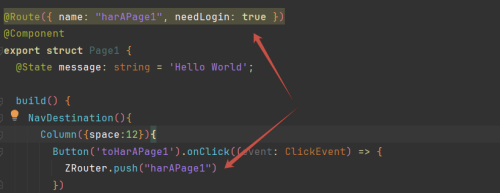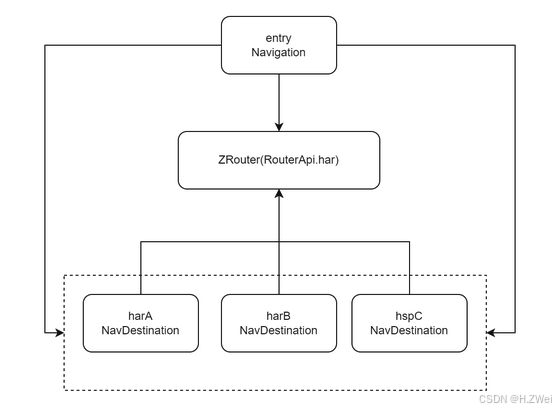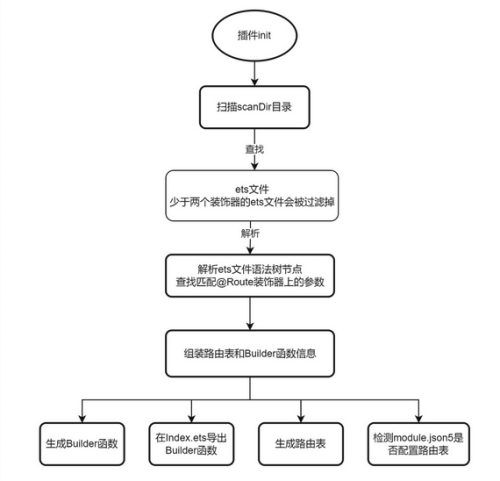# ZRouter
**Repository Path**: common-apps/ZRouter
## Basic Information
- **Project Name**: ZRouter
- **Description**: ZRouter是一款轻量级且非侵入性的鸿蒙动态路由框架,可解决HAR/HSP业务模块间的耦合与通信问题,提供了自定义拦截器、服务路由、转场动画、生命周期函数管理、NavDestination模板化等功能。
- **Primary Language**: TypeScript
- **License**: Apache-2.0
- **Default Branch**: main
- **Homepage**: None
- **GVP Project**: Yes
## Statistics
- **Stars**: 180
- **Forks**: 32
- **Created**: 2024-07-19
- **Last Updated**: 2025-12-03
## Categories & Tags
**Categories**: harmony, harmonyos-devtools
**Tags**: 鸿蒙, 路由, Router, navigation, OpenHarmony组件
## README
## 介绍
ZRouter是一款轻量级且非侵入性的鸿蒙动态路由框架,可解决HAR/HSP业务模块间的耦合与通信问题。主要特性:
- 简化Navigation使用,无需关注路由表的配置,对Navigation及NavDestination组件保持零侵入;
- **支持API链式调用,让API更简洁直观;**
- **为了进一步简化使用,支持NavDestination页面模板化,是一个可选项;**
- 注解参数支持使用静态常量,可跨模块定义;
- 支持自定义拦截器,可实现页面重定向、登录验证、数据预取、埋点等业务场景。
- **支持服务路由,可实现Har/Hsp模块间的通信;**
- 支持全局及单个页面的生命周期函数管理,可使任意类都能享有与组件相同的生命周期特性,可用于页面埋点统计等业务场景;
- 支持跨多级页面参数携带返回监听;
- 支持自定义URL路径跳转,可在拦截器内自行解析URL实现业务逻辑;
- 内置多种转场动画效果(平移、旋转、渐变、缩放、高斯模糊、共享一镜到底动画),并支持自定义动画;
- 支持启动模式、混淆、嵌套Navigation、Hap、**元服务**;
- **支持与您现有项目中的Navigation无缝融合,实现零成本向本库迁移;**
- 支持ArkUI-X跨平台上使用;
- 支持第三方应用Navigation的使用本库API;
**使用十分简单,没有繁琐的配置,两行代码就可以完成页面的跳转**,如下:
[](https://img.z4a.net/image/WX20250805-102507.lQeP3)
ZRouter已上架录入到[华为鸿蒙生态伙伴组件专区](https://developer.huawei.com/consumer/cn/market/landing/component)
## 快速入门
[ZRouter快速入门](https://gitee.com/common-apps/ZRouter/wikis/ZRouter%20%E5%BF%AB%E9%80%9F%E5%85%A5%E9%97%A8)
## **router-register-plugin编译插件 — 很重要**
### 下载安装
**在项目根目录的hvigor目录下的`hvigor-config.json5`文件中配置安装**
[](https://imgse.com/i/pEovcrt)
```
"dependencies": {
"router-register-plugin":"x.x.x"
},
```
**编译插件最新版本**: 
[](https://www.npmjs.com/package/router-register-plugin)
最后记得Sync Now或重新build让插件安装生效。
或者使用hvigorw命令行工具执行任一命令,命令行工具会自动执行安装构建依赖。
```
hvigorw --sync
```
### 配置
支持两种配置方式:
- **工程级配置**: 即在工程根目录下的hvigorfile.ts文件中全局配置;
- **模块级配置**:即在每个模块目录下的hvigorfile.ts文件中单独配置;
> 不建议一个项目同时使用两种配置方式,虽然是这种混合方式也是支持的,但容易出现配置冲突。模块级配置相对繁琐些,但配置项会更精细化些。
步骤:
```
// 1、导入
import { routerRegisterPlugin, PluginConfig } from 'router-register-plugin'
// 2、初始化配置
const config: PluginConfig = {
scanDirs: ['src/main/ets/pages', 'src/main/ets/views'], // 扫描的目录,如果不设置,默认是扫描src/main/ets目录
logEnabled: true, // 查看日志
viewNodeInfo: false, // 查看节点信息
ignoredModules:['RouterApi','common','xxx'], // 忽略的参与构建的模块,根据自己项目自行设置
enableUiPreviewBuild: false, // 启用UI预览构建,不建议启动
}
export default {
// 3、添加插件
plugins:[routerRegisterPlugin(config)]
}
```
> **注意:hvigorfile.ts文件中默认配置不要删除了。**
配置参数说明:
| 参数名 | 类型 | 默认值 | 描述 |
|----------------------------------|----------|-------------------|------------------------------------------------------------------------------|
| `scanDirs` | string[] | ['src/main/ets'] | 扫描的目录,如果不设置,默认是扫描src/main/ets目录。建议配置该字段,避免扫描所有目录,影响工程编译效率** | |
| `logEnabled` | boolean | true | 是否打印日志 | |
| `viewNodeInfo` | boolean | false | 查看节点信息,只有与logEnable同时为true才会打印输出 |
| ~~`isAutoDeleteHistoryFiles`~~ | boolean | false | 是否在构建时删除编译产物,已弃用,在项目`clean`自动删除无用编译产物,请不要设置此参数。 | |
| `lifecycleObserverAttributeName` | string | lifecycleObserver | 如果使用了NavDest页面模板化功能,该配置字段会生效,默认属性名是lifecycleObserver,也可以在@Route注解上单独设置这个属性 |
| **`ignoredModules`** | string[] | [] | 忽略需要扫描的模块,填写模块名称,默认是全部模块;**插件在工程级时使用**,该字段才会生效。**建议配置该字段,避免扫描所有模块,影响工程编译效率** |
| `enableUiPreviewBuild` | boolean | false | 是否在ui预览构建时生成,默认不启用, 会降低ui预览构建效率 |
> **注意:** 以上配置参数都是可选的,建议配置`scanDirs`和`ignoredModules`字段,避免扫描所有目录和模块,影响工程编译效率。
编译阶段会自动生成一些文件,建议在git的`.gitignore`忽略掉这些文件。
```gitignore
_generated
**/route_map.json
**/router_map.json
```
## ZRouter的基本使用
### 下载安装
在每个har/hsp模块中,通过ohpm工具下载安装库:
```
ohpm install @hzw/zrouter
```
### 页面跳转
新建三个模块分别是harA、harB、hspC,三者之间没有依赖关系,entry模块依赖了这三个模块,通过ZRouter可以在四个模块间相互跳转,从而达到模块解耦效果。模块关系图如下图:
[](https://img.z4a.net/image/ohos-zrouter-1.lQ0uz)
1、在EntryAbility的onCreate()方法中初始化ZRouter,**建议使用initialize()方法进行初始化,init()方法已弃用**
```
onCreate(want: Want, launchParam: AbilityConstant.LaunchParam): void {
// 如果项目中存在hsp模块则传入true
ZRouter.initialize((config) => {
config.isLoggingEnabled = BuildProfile.DEBUG
config.isHSPModuleDependent = true
})
}
```
**建议在`AbilityStage`的`onCreate()`方法中完成初始化**
```typescript
export class AppAbilityStage extends AbilityStage{
onCreate(): void {
// 应用HAP首次加载时触发,可以在此执行该Module的初始化操作(例如资源预加载、线程创建等)。
// 在module.json5配置文件中,通过配置 srcEntry 参数来指定模块对应的代码路径,以作为HAP加载的入口。
// 初始化路由
ZRouter.initialize((config) => {
// 设置context
config.context = this.context
config.isLoggingEnabled = BuildProfile.DEBUG
config.isHSPModuleDependent = true
// 服务路由初始化配置,如果没有使用服务路由,可不设置
config.loadDynamicModule = ['@hzw/hara', 'harb', 'hspc']
config.onDynamicLoadComplete = () => {
console.log("已完成所有模块的加载")
}
})
}
}
```
2、在Index页面**使用Navigation作为根视图,通过ZRouter的`getNavStack()`方法获取NavPathStack实例,将其传入到Navigation的构造函数中。**
**如果在Index入口文件中启动Splash页面,建议放在Navigation的`onAppear`方法中进行启动,或者组件的`onPageShow`方法**,具体可参考demo
```
// Index 中使用 aboutToAppear 生命周期函数会因为 Navigation 还没初始化完成导致无法有效跳转,可使用替换成 onPageShow
@Entry
@Component
struct Index {
build() {
// 获取NavPathStack实例对象
Navigation(ZRouter.getNavStack()){
Column({space:12}){
Button('toHarAMainPage').onClick((event: ClickEvent) => {
// 跳转页面
ZRouter.push("harAMainPage")
})
}
}
.title('Main')
.height('100%')
.width('100%')
.onAppear(() => {
// 启动Splash页面
ZRouter.push("SplashPage")
})
}
}
```
通过ZRouter的pushXX()方法进行页面跳转,参数是@Route装饰器上的name属性值;~~或者用ZRouter的getNavStack()方法来执行页面跳转~~。
3、**在NavDestination子页的使用自定义`@Route`或`@ZRoute`注解标注页面**,其中name属性是必填的,页面跳转需要用到name值,还有另外三个可选属性分别是:
- description:页面描述,没有功能作用;
- needLogin:如果页面需要登录,可以将值设置为true,然后在拦截器中做页面重定向到登录页;
- extra:额外的值可以通过该属性设置
> @Route/@Service/@ZAttribute/@ZLifecycle等自定义注解上的name属性支持使用静态常量,在后面文档有详细介绍
代码如下:
```
@Route({ name: 'hspCPage1', needLogin:true ,extra: 'hsp'})
@Component
export struct Page1 {
@State message: string = 'Hello World';
build() {
NavDestination(){
Column({space:12}){
Button('toHarAPage1').onClick((event: ClickEvent) => {
ZRouter.push("harAPage1")
})
}
}
.title('hspCPage1')
.width('100%')
.height('100%')
}
}
```
> 如果觉得每个页面都要用NavDestination组件包裹太麻烦,可以使用[NavDestination模板化功能](https://gitee.com/common-apps/ZRouter/wikis/NavDestination%E9%A1%B5%E9%9D%A2%E6%A8%A1%E6%9D%BF%E5%8C%96%E8%83%BD%E5%8A%9B)。
**建议通过ZRouter.getInstance()方式来操作路由的跳转与关闭,使用会更灵活简洁,之前的ZRouter的静态方法依然保留着,在1.2.0版本起将标记为过期状态了。**
```typescript
ZRouter.getInstance()
.setParam("root data")
.setLunchMode(LaunchMode.STANDARD) // 启动模式
.setAnimate(true)
.setPopListener((r) => {
LogUtil.log("index result: ", r.data ," from: ", r.from);
})
.navigation("harAPage3")
```
### 全局拦截器
全局拦截器每个页面跳转都会触发,可以拦截器中做页面跳转的拦截,比如跳转前拦截、数据预取、登录拦截,404拦截、埋点、自定义URL路径等等。
代码示例:
```typescript
export class GlobalNavigateInterceptor implements IGlobalNavigateInterceptor{
static count = 0
onNavigateBefore: (destInfo: DestinationInfo) => Promise = (destInfo) => {
console.log("IInterceptor Global onNavigateBefore -> ", destInfo.name)
return new Promise((resolve, _) => {
if (destInfo.name === RouterConstants.PAGE_BEFORE_PUSH) {
// 拦截跳转到ParamPage页面
if (GlobalNavigateInterceptor.count === 0) {
destInfo.param = ' 在拦截器onNavigateBefore中已替换参数 '
destInfo.next() // 继续跳转 默认的 ,可以不写
} else if (GlobalNavigateInterceptor.count === 1) {
ToastUtils.show("拦截器onNavigateBefore中已拦截, 再点一次会继续执行")
destInfo.block() // 拦截跳转
} else if (GlobalNavigateInterceptor.count === 2) {
destInfo.name = RouterConstants.LIFECYCLE_CASE_VIEW
}
GlobalNavigateInterceptor.count += 1
}
resolve(destInfo)
})
}
onRootWillShow: ((fromContext: NavDestinationContext) => void) | undefined = (fromContext) => {
console.log("IInterceptor Global onRootWillShow: ", fromContext.pathInfo.name)
}
onPageWillShow: ((fromContext: NavDestinationContext, toContext: NavDestinationContext) => void) | undefined = (from ,to)=>{
console.log("IInterceptor Global onPageWillShow: ", from, to.pathInfo.name, to.pathInfo.param)
}
onNavigate: ((context: InterceptorInfo) => void) | undefined = (info)=>{
if (info.notRegistered) return
console.log("IInterceptor Global onNavigate -> ", info.name)
let isLogin = AppStorage.get("isLogin")
if (info.isNeedLogin && !isLogin) {
let param = info.param
ZRouter.getInstance()
.setParam(param)
.setAnimate(true)
.setPopListener((result) => {
if (result.data) {
// 登录成功
promptAction.showToast({ message: `登录成功` })
return true // 返回true 则继续跳转登录前的页面
} else {
return false
}
})
.redirect("LoginPage", RedirectType.REPLACE)
}
}
}
// 添加拦截器
ZRouter.setGlobalInterceptor(new GlobalNavigateInterceptor())
```
当页面未注册时,可以通过以下方式处理:
* 跳转到404页面:使用 `redirect() `方法直接重定向到404页面
* 跳转到登录页面:使用 `redirect() `方法跳转到登录页,并可以设置回调函数处理登录结果
登录setPopListener的回调函数工作流程:
* 登录成功时,回调函数返回 `true`,继续跳转到原来的目标页面
* 登录失败或取消时,回调函数返回 `false`,停止跳转
登录页面代码示例:
```
@Route({ name: 'LoginPage'})
@Component
export struct LoginPage{
build() {
NavDestination(){
Column({space:15}){
Button('登录成功').onClick((event: ClickEvent) => {
// 模拟登录
AppStorage.setOrCreate('isLogin', true)
ZRouter.finishWithResult(true)
})
}
.width('100%')
.height('100%')
}
.width('100%')
.height('100%')
.title('LoginPage')
}
}
```
在登录成功后通过`ZRouter.finishWithResult()`方法携带数据关闭页面,内部会将状态传递给`redirectForResult2()`方法中的回调函数,最终在`setPopListener`中接收处理。
## NavDestination页面模板化
在介绍基本使用的流程中,我们知道每个页面都需要通过NavDestination来包裹,这样会造成代码的冗余,因此可通过ZRouter的模板化能力将NavDestination层去除。
具体使用见[详细文档](https://gitee.com/common-apps/ZRouter/wikis/NavDestination%E9%A1%B5%E9%9D%A2%E6%A8%A1%E6%9D%BF%E5%8C%96%E8%83%BD%E5%8A%9B)
## 自定义URL路径跳转
在项目中一般会设计一套统一的URL路径跳转规范,通过URL路径跳转到不同原生页面。比如下面的URL路径:
```typescript
hzw://hello?id=69&name=harAPage3
```
获取URL路径上的name参数进行跳转原生页面,可以设置一个拦截器来拦截URL路径跳转。代码示例:
跳转:
```typescript
Button('https://www.baidu.com?id=66&name=hspCIndex').onClick((event: ClickEvent) => {
ZRouter.getInstance()
.navigation("https://www.baidu.com?id=66&name=hspCIndex")
})
Button('hzw://hello?id=69&name=harAPage3').onClick((event: ClickEvent) => {
ZRouter.getInstance()
.navigation("hzw://hello?id=69&name=harAPage3")
})
```
拦截器:
```typescript
export class UrlInterceptor implements IInterceptor {
// 设置拦截器优先级,数值越大则优先执行
priority: number = 10000;
process: (context: InterceptorInfo) => InterceptorInfoOrNull = (context) => {
console.log("IInterceptor process: ", this.priority , context.name)
// 自定义URL路径是没有注册的
if (context.notRegistered) {
// 如果是URL路径跳转
if (this.isLink(context.name)) {
// 拦截到URL路径跳转,进行处理
const map = this.parseQueryString(context.name)
const name = map.get('name')
if (name) {
// 跳转原生页面
ZRouter.getInstance()
.setParam(map.get("id"))
.navigation(name)
}
} else {
ZRouter.getInstance().redirect("PageNotFound2")
}
return null // 返回null则拦截掉
}
return context
};
isLink(str: string): boolean {
const linkRegex = /^(hzw:\/\/|http:\/\/|https:\/\/|www\.).+/;
return linkRegex.test(str);
}
parseQueryString(queryString: string) {
let params = new HashMap();
let queryStringWithoutQuestionMark = queryString.split('?')[1];
if (queryStringWithoutQuestionMark) {
let keyValues = queryStringWithoutQuestionMark.split('&');
keyValues.forEach((keyValue) => {
let pair = keyValue.split('=');
let key = decodeURIComponent(pair[0]);
let value = decodeURIComponent(pair[1]);
params.set(key, value)
})
}
return params;
}
}
```
**上面的逻辑也可以放在全局拦截器的`onNavigateBefore()`方法中处理。**
## 注解上使用静态常量,可跨模块定义
router-register-plugin插件1.0.7版本起,@Route与@Service注解的name属性可使用静态常量,方便统一管理路由名称;静态常量支持当前模块或跨模块定义,常量的定义模版如下:
```typescript
export class RouterConstants {
public static readonly URL_TEST_PAGE: string = "url_test";
public static readonly HARA_MAIN_PAGE :string = "harAMainPage"
}
```
> 如果路由常量在一个公共模块定义,建议在模块的Index.ets文件导出,另外RouterConstants的文件必须是.ets后缀,不支持ts后缀文件。[具体可参考案例](https://gitee.com/common-apps/ZRouter/tree/master/library/common)
## 服务路由-模块间通信
服务路由主要用于实现模块之间的通信,模块间是相互独立且不直接依赖于彼此。
> 1.0.9版本开始支持,具体使用可见[详情文档](https://gitee.com/common-apps/ZRouter/wikis/%E6%9C%8D%E5%8A%A1%E8%B7%AF%E7%94%B1%E2%80%94%E6%A8%A1%E5%9D%97%E9%97%B4%E9%80%9A%E4%BF%A1) 或者参考demo
## 生命周期函数管理
ZRouter的组件生命周期管理能力,主要有两个特点:
- 不影响你原有的生命周期业务逻辑,对NavDestination页面保持着零侵入性,整合了组件通用生命周期函数和NavDestination生命周期函数
- 可以让任何一个类具备有与组件的生命周期能力;
具体使用见[详细文档](https://gitee.com/common-apps/ZRouter/wikis/%E7%94%9F%E5%91%BD%E5%91%A8%E6%9C%9F%E7%AE%A1%E7%90%86%E8%83%BD%E5%8A%9B)
## 路由转场动画
从1.1.1版本起内置了转场动画(平移、旋转、渐变、缩放、高斯模糊),也支持自定义转场动画;具体使用见[详细文档](https://gitee.com/common-apps/ZRouter/wikis/%E8%B7%AF%E7%94%B1%E8%BD%AC%E5%9C%BA%E5%8A%A8%E7%94%BB)
## 第三方Navigation实例使用本库的API
如果第三方Navigation实例使用本库的API,需要将第三方Navigation的NavPathStack实例注册到ZRouter中,代码示例:
```typescript
aboutToAppear(): void {
// 在合适的时机注册导航栈
// let s = ZRouter.getNavStackByName(NAV_STACK_NAME)
ZRouter.registerNavStack(NAV_STACK_NAME, this.stack)
}
aboutToDisappear(): void {
ZRouter.unregisterNavStack(NAV_STACK_NAME)
}
```
上面是模拟代码,具体注册的时机需要根据实际情况来定。NAV_STACK_NAME是一个自定义常量,用于标识导航栈的名称。
页面跳转:
```typescript
Column({ space: 15 }) {
Text(this.msg)
Button("harAMainPage").onClick((event: ClickEvent) => {
ZRouter.getInstance(NAV_STACK_NAME)
.setAnimate(true)
.setPopListener((v) => {
this.msg = v.data?.toString() + ' ' + v.from?.toString()
})
.navigation("harAMainPage")
})
}
```
把标识导航栈的名称NAV_STACK_NAME,入参到ZRouter.getInstance()方法中,就可使用ZRouter的API。
## 在ArkUI-X项目上的使用
router-register插件在ArkUI-X项目的配置有所不同,需要使用者自己手动修改下hvigorfile.ts文件,详细见[ArkuiX-ZRouter](https://gitee.com/common-apps/ArkuiX-ZRouter),或者[issues IB35F5](https://gitee.com/common-apps/ZRouter/issues/IB35F5)
## 混淆
生产环境需要在每个模块的obfuscation-rules.txt文件添加混淆配置:
```
-keep-file-name
Index
_generated
ZR*
```
## 工作原理
路由注册流程代码是由插件在编译阶段自动化生成,其原理是不难的,通过Hvigor插件扫描指定目录的ets文件,递归解析ets文件的语法树节点,查找解析注解上的参数,然后将这些信息通过模板引擎生成对应的代码逻辑。
> 与Java注解处理器原理是类似的
ZRouter库是对NavPathStack对进行高度封装的,包括了页面跳转、自定义拦截器、服务路由、生命周期回调、转场动画、NavDestination模板化等功能,提供了更简洁易用的API,其中部分思想参考了Android [ARouter](https://github.com/alibaba/ARouter)路由框架。
编译插件的基本流程图:
[](https://img.z4a.net/image/WX20250805-103406.lQFjc)
## 接口列表
[查看详细文档](https://gitee.com/common-apps/ZRouter/wikis/%E6%8E%A5%E5%8F%A3%E5%88%97%E8%A1%A8?sort_id=13047549)
## FQA
[查看详细文档](https://gitee.com/common-apps/ZRouter/wikis/FQA)
## 源码
- gitee:https://gitee.com/common-apps/ZRouter
- github:https://github.com/751496032/ZRouter
## 参与贡献
- Fork 本仓库
- 新建分支
- 提交代码
- 新建 Pull Request
## 待优化项
- **服务路由**:~~支持在entry模块动态注册;~~
- **拦截器**:
- `onNavigateBefore()`兼容系统push 等api拦截;
- ~~`onNavigateBefore()`支持获取注解中的参数;~~
- **页面模板化**:在模板化下支持页面路由组件直接参数携带,非模板功能已支持了;
- **页面跳转**:~~支持元服务hsp模块动态下载~~
- **动画**:支持注解的方式
- **编译插件**:~~适配DevEco Studio 5.1.1~~
## 联系我们
**欢迎大家提交issue、PR等建议(可以统一收集问题,方便更多人查阅,会第一时间回复处理)** ,或进群交流(+wx: 751496032)。
> 加wx备注:鸿蒙
[](https://img.z4a.net/image/wx-me-code.lQyNu)